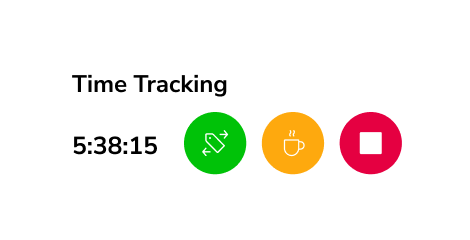8 Best Practices for Desktop Time Tracking
Desktop time trackers have a number of unique advantages compared to mobile or web time tracking apps. For one thing, they offer a much higher level of employee monitoring, with some capable of tracking app and site usage, detecting idle time, and even capturing screenshots.
Desktop time trackers can also keep tracking time even when offline, since they’re installed directly into your computer system. On top of all that, they’re generally faster and more responsive than web-based applications, since they run natively on the user’s computer.
These are some of the reasons why many companies choose this time tracker. But even if it looks simple to use, how can you make sure you’re getting the most out of it?
In this article, we’ll share eight best practices for using desktop time tracking tools effectively. These tips can help you boost productivity, work more efficiently, and reach your goals faster.
And while we focus on desktop tools, you can apply these practices to any time tracking setup and still see great results.
What Should You Look For in a Desktop Time Tracker?
Before you can apply the desktop time tracking best practices outlined in this article, you’re going to need the right desktop time tracker to start with. So let’s dig into that first.
With so many desktop time trackers available, how do you pick the right one? What features should you look for? Well, the answer depends on what you need.
For example, if you manage a remote team, you might want a tracker that includes employee monitoring tools. If your team handles multiple projects, having built-in project management features can be a big help.

Photo by Tran Mau Tri Tam on Unsplash
Having said that, there are some essential features that are somewhat non-negotiable for effective desktop time tracking, this includes:
- User-friendly interface: Choose a time tracker that’s easy to use so you and your team can get started without much training. Some even offer shortcuts to save time.
- Real-time tracking: Make sure the tool shows time and progress updates as they happen. This helps you spot issues and adjust your workflow right away.
- Task and project labels: Look for a tracker that lets you organize your work by task or project. This helps you manage time better and makes it easier to bill clients.
- Reports and analytics: Good time trackers provide clear reports that show how your time is spent. Customizable reports help you make smarter decisions.
- Automated time tracking: Choose a tool that can automatically clock you in or out when your desktop locks, goes to sleep, or wakes up, so your timesheets stay accurate without manual input.
- App integrations: Pick a tracker that works well with the other tools you use—like calendars, invoicing software, or project management apps. This saves time and avoids double work.
- Customization: Everyone works differently, so it’s helpful if the tracker lets you adjust settings to fit your needs.
- Data security: Since time trackers collect sensitive info, make sure the tool protects your data with strong security features and follows privacy laws.
For more information reffer to our Complete Guide to Desktop Time Tracking.
8 Best Practices for Desktop Time Tracking
Effective desktop time tracking is crucial for productivity and accountability in today’s professional landscape. To make the most of this essential tool, consider implementing these eight best practices:
1. Communicate WHY tracking time is necessary
Employees may initially view time tracking as intrusive or unnecessary. And don’t make the mistake of just forcing it on them. Instead, it’s crucial to clearly articulate why time tracking is necessary.
For hourly employees, emphasize how a time tracker can ensure that they are accurately compensated for the work they put in. You can also explain how it helps with resource allocation, project planning, and ensures everyone’s efforts are recognized and rewarded fairly.
By communicating the “why” of time tracking, you help everyone involved see the value in the process. It ensures that time tracking is not seen as a mere obligation but as a tool for achieving individual and team objectives. This communication builds trust and encourages employees to buy-in.
2. Establish clear work boundaries
Clear work hours are important, especially for remote or flexible teams. Use your time tracking app’s scheduling feature to define when the workday starts and ends. For example, Jibble lets you set custom schedules and send reminders when it’s time to clock in or out.
Encourage your team to track time only during actual working hours and when they’re focused on tasks. Make sure they know not to track personal breaks or unrelated activities. This keeps tracking fair and helps avoid burnout.
You can also use a time tracker that labels apps and tasks as work or non-work. This helps the system track time more accurately and ensures it only logs productive work.
3. Start with a pilot program
For those new to time tracking or implementing it within a team, starting with a pilot program is a good way to go. Instead of rolling out a full-scale time tracking initiative immediately, begin with a smaller group or limited scope.
This allows you to test the chosen desktop time tracking tool, evaluate its effectiveness, and address any challenges or concerns on a smaller scale. Once you’ve ironed out any issues and are confident in the process, you can then expand the program to the entire team or organization.
A pilot program provides a smoother transition and minimizes disruption while ensuring a successful implementation of desktop time tracking.
For more tips on implementing the software, read How to Introduce Time Tracking to Your Team.
4. Organize time around clients and projects
Efficient time tracking also involves structuring your work around the clients and projects you are involved in. This practice allows you to allocate time and resources more effectively, ensuring that your efforts are aligned with your priorities.
Use a desktop time tracker to categorize your work into specific projects and associate it with clients so you can gain a clear overview of where your time is being spent.
This organization not only helps in accurately tracking billable hours but also ensures you focus on the most critical tasks. Plus it helps to simplify the overall process of generating invoices or reports for clients and stakeholders, as your time data is already neatly organized by project.
5. Use employee monitoring features with caution
Desktop time trackers offer a much higher level of employee monitoring, with some being able to track app and web usage, and others even having a time tracking with screenshots feature.
These features are useful for managing remote teams or when oversight is needed. But they should be used carefully to respect employees’ privacy and build trust.
Be clear and open about monitoring. Let your team know what’s being tracked and why. Tools like Jibble have privacy features that help with this—for example, blurring screenshots or sending notifications when screenshots are taken.
Monitoring isn’t a bad thing when done right. It can help teams stay on track and highlight where extra support is needed.
6. Regularly review and analyze your time data
Data is only as good as how you analyze and use it. Make it a routine to review your time tracking data. You can leverage the reports that time trackers generate to identify work patterns, bottlenecks, or inefficiencies.
Check on how much time is spent per project or task. Are you meeting project goals? Which tasks eat up the most time?
By consistently reviewing this data, you gain valuable insights into your work habits and how you allocate your time. You can identify trends, pinpoint areas where productivity could be improved, and make informed decisions about optimizing your workflow.
7. Leverage integrations and automation
To get the most out of desktop time tracking, use integrations. Many time trackers can connect with the tools you already use, which helps you save time and work more efficiently.
For example, Jibble can integrate with project management tools like Asana and Trello. This means the time you track can be automatically linked to the right project, so you don’t have to enter the same data twice. Jibble also works with payroll systems, CRM tools, and messaging apps.
In addition to integrations, look for automation features. Some time trackers let you set up reminders, notifications, or rules for tracking certain tasks. These features help you keep time records accurate and make sure nothing important gets missed.
Ready to integrate but not sure how? Check out How to Upgrade Desktop Time Tracking with Integrations.
8. Adjust and optimize your approach
Your time tracking system shouldn’t stay the same forever. As your work changes, be open to adjusting how you track time.
For example, if you’ve been using a time tracker for a few months and still missing deadlines on certain projects, it might be time to change things. You could try spending more focused time on those projects or reassigning tasks.
By regularly reviewing your time tracking data and making changes, you’ll improve how you manage time and get more done.
Final Thoughts on Desktop Time Tracking
So there you have it, eight desktop time tracking best practices. From clearly articulating the “why” of time tracking to creating a structured and efficient system of categorizing your tasks, these practices, as simple as they seem, can help you make the most of your chosen desktop time tracker.
Remember that while these practices provide a solid foundation, every work environment is unique. Feel free to adapt and refine these practices to suit your specific needs and requirements. The key is to maintain a commitment to effective time tracking and continuous improvement.
Incorporating these best practices, along with the ultimate desktop time tracking app, can be a game-changer in achieving your time management goals. Try them out and see for yourself!
Related Articles:
The Ultimate Desktop Time Tracking App
How to Roll Out Time Tracking Software (without getting fired!)
How Far Can Desktop Time Trackers Go – Legally?
Desktop vs. Web Time Tracking: Finding the Ideal Solution For You


